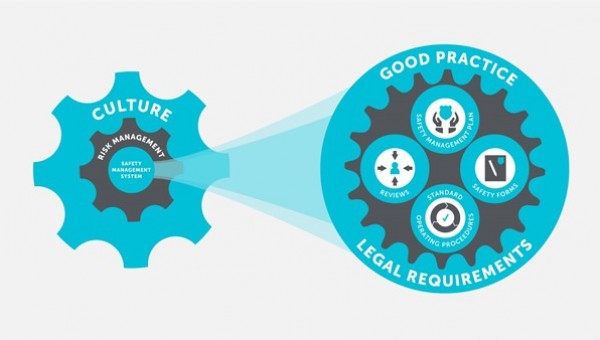Good Practice
Good practice refers to what is currently accepted by the sector and regulators as meeting your legal responsibilities to manage risk. You must operate at good practice or better to meet your legal responsibilities.
Ideally, good practice is recorded. The Activity Safety Guidelines (ASGs) and Good Practice Guidelines (GPGs) are the usual go-to. Other ways good practice is indicated include codes of conduct, professional association guidelines, and qualification syllabuses.
Finding reliable information
Knowing where to find and how to identify reliable good practice information is critical. It’ll often involve using a combination of technical advice and written resources.
Sometimes there aren’t reliable good-practice documents and, given technical advisors’ knowledge and skills, good practice may reside with them.
Technical advisors
Every provider must have access to sufficient technical knowledge specific to the activities they provide to make good safety decisions. People who fulfill this role are called technical advisors. They may be on staff or be contracted to give advice, particularly on policies, procedures, hazards, risks, and planning reviews.
Note: Technical advisors must have a high level of competence and will usually hold a high-level qualification in the activity. They must understand current good practice and have knowledge and skills sufficient to advise a provider.
Written resources
The sector and government develop a range of written resources to support good practice, including guidelines, codes of practice, and standards.
When deciding how much to rely on a document, ask the following:
• Is it linked to a regulatory requirement?
• Is it informed by experts?
• Is it current?
• Do the majority of providers consider the document represents good practice?
• Does it cover all relevant topic areas? If it doesn’t, access other documents to fill the gaps.
There are many activity organisations, some of which have safety-guidance material. While the quality may vary, this information may be helpful. Consider the criteria above when considering how much to rely on the information.
Good practice information for adventure activities
The information in this document is split into two tables: Table 1 for activities with Activity Safety Guidelines (ASGs) and Table 2 for activities without ASGs.
Table 1 - Activities with ASGs:
| Adventure Activity | Activity Safety Guideline | Information from regulators |
|
||
|
||
|
||
|
||
|
||
|
||
|
||
|
||
|
||
|
||
|
Table 2 - Activities without ASGs:
Good practice guidelines for non-adventure activities
Good Practice Guidelines (GPGs) are for organised outdoor activities that aren’t currently covered by the Adventure Activities Regulations or the associated Activity Safety Guidelines (ASGs).
They are primarily designed for youth organisations, recreational clubs, schools, outdoor centres, and commercial adventure operators, and can be used by part-time and volunteer outdoor educators or instructors to help plan an activity. GPGs are particularly useful for programme managers who want to align their procedures and systems with good practice.
General guidance for organised outdoor activities
General Guidance for Organised Outdoor Activities covers all activity types and gives an overview of common safety considerations.
Overarching risk management guidance
Overarching Risk Management Guidance (v2) shows how the risk ratings for each GPG and activity planning template were created.
Use it alongside the safety management system information to guide the development of your safety system and to ensure you understand how the GPGs and activity planning templates should be used.
Driving - guidelines and checklists
Driving Good Practice Guideline (v1) provides guidance for driving to and from activities, as well as checklists for before, during, and after a trip.
Emergency communication
Emergency communication for remote activity providers
Accessibility and Inclusion
Accessibility and Inclusion in Outdoor Education and Recreation Guide
Increasing Participation of Muslim Women and Girls - Good Practice Guide
Activity Good Practice Guidelines (GPGs) and Activity Planning Templates
These documents are designed to be used together.
Activity Good Practice Guidelines give an overview of safety considerations for specific outdoor activities or sets of activities while activity planning templates are an editable document that can be used to create an activity safety plan.
- Adventure based learning
- Archery
- Beach and Surf Activities
- Camp fire cooking and fires
- Environmental Service
- Flatwater Floating and Paddling
- Inland Waterway Swimming
- Low Ropes and Confidence Courses
- Map Based Activities
- Non-technical Caving
- Overnight Camping
- Sliding Activities
- Snorkelling
- Target Shooting
- Tramping
Activity good practice guidelines development
Good practice guidelines are developed and reviewed as a collaborative effort led by Recreation Aotearoa and Education Outdoors NZ with help from the following working groups:
Generic guidelines and overnight camping
David Mangnall, Fiona McDonald, Mark Smith, Rob MacLean
Overarching risk management
David Mangnall, Fiona McDonald, Mark Smith, Rob MacLean, Alex Warriner
Driving
Mark Smith (facilitator), Stu Allan, Adventure Specialties, St John of God Hauora, Outward Bound New Zealand
ABL
Mark Smith, Liz Penman
Archery and target shooting
David Mangnall (facilitator), Gus Johannes, Alex Warriner, Philip Seed, Manu Schijf, Jonathon Hall
Beach and surf activities
Mark Smith (facilitator), Ross Merrett- Surf Life Saving New Zealand
Camp fire cooking and fires
Mark Smith, Alex Warriner, Judith Bright, James Bruce
Environmental service
Jen Riley (facilitator), Matt Stanford, Lou Drage, Dave Sharp, Celia Hogan, Shannon Corkill, Rosie Joyce
Flatwater
David Mangnall (facilitator), Liz Thevenard, Joolz Mathews
Inland waterway swimming
David Mangnall (facilitator), Liz Thevenard, Joolz Matthews, Nathan Watson, Lynley Steward
Low ropes and confidence courses
Liz Penman, Mark Smith
Map-based activities
David Mangnall (facilitator), Jean Cory-Wright, Russell Higham
Non-technical caving
Jen Riley (facilitator), Angus Stubbs, Keiran McKay, Hillary McDonald, Keiran Chandler, Richard Kersell, Kate Parr, Steven Gread
River activity
David Mangnall (facilitator), Liz Thevenard, Joolz Mathews, Nathan Watson, Lynley Stewart
Sliding activities
David Mangnall (facilitator), Gus Johannes, Alex Warriner, Philip Seed, Debbie Wanhill, Manu Schijf, Jonathan Hall
Snorkelling
Liz Penman (facilitator), Samara Nicholas, Manu Schijf, Tim Wills, Yuin Khai Foong
Tramping
David Mangnall and Bevan Smith
Funding
Initial project funding was provided by Education Outdoors New Zealand, Recreation Aotearoa, Sport New Zealand, Tourism Industry New Zealand Trust, Girls Brigade New Zealand, Scouts New Zealand and Christian Camping New Zealand. Ongoing development is funded by Education Outdoors New Zealand and Recreation Aotearoa.


